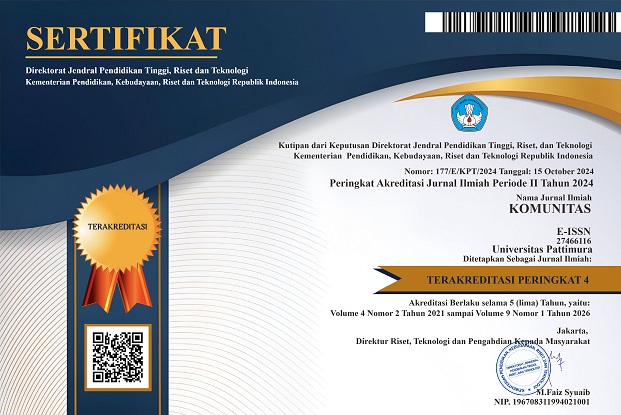Kusing-Kusing di Negeri Seith, Kecamatan Leihitu Kabupaten Maluku Tengah: Kajian Sosiologi Masyarakat Pesisir
Abstract
Abstrak
Penelitian ini bertujuan untuk mengetahui dan menganalisis kontribusi Kusing dalam merawat hubungan kekerabatan di negeri Seith. Penelitian ini merupakan studi kualitatif dengan pendekatan studi kasus. Subjek dari penelitian ini adalah 10 orang masyarakat negeri Seith yang didalamnya memiliki peran di masyarakat dan mengetahui tentang Kusing. Pengambilan data dalam penelitian ini dilakukan dengan wawancara secara langsung dengan para narasumber. Hasil penelitian menemukan istilah Kusing bermula dari Istilah Kaum Malono dan Kaum Mahina, ada juga istilah dari Ua-ua dan Mahina Ulu. Istilah dari Kaum Malono yang biasa di ambil dari keluarga Laki-laki sedangkan Kaum Mahina diambil dari keluarga perempuan. Sedangkan Ua-ua dan Mahina Ulu itu di ambil dari sudara perempuanya laki-laki, dan Mahina Ulu di ambil dari istri dari sudara laki-laki. Yang dalam hal ini bukan hanya saudara kandung saja, tetapi diambil dari persepupuan, dan kerabat-kerabat lainya, seperti Ipar yang masuk pada Mata rumah tersebut. Inilah yang mendasari budaya kusing ini, Sehingga Timbul yang di sebut dengan budaya Basangaja atau Kusing. Kusing merupakan ikatan yang kompleks dengan disertai struktur dan fungsi untuk menjaga kestabilan dan keberlanjutan masyarakat dalam konteks hubungan kekerabatan. Kusing berkontribusi untuk merawat hubungan kekerabatan di negeri Seith tidak hanya memperkuat ikatan antara anggota keluarga, tetapi juga memelihara warisan budaya dan sosial yang kaya di dalamnya, yang berjalan berdasarkan struktur fungsi yang berlaku didalam matarumah.
Kata Kunci: Fungsi, kebudayaan, kusing, negeri Seith
Abstract
This research aims to determine and analyze Kusing's contribution to maintaining kinship relations in the Negeri Seith. This research is a qualitative study with a case study approach. The subjects of this research were 10 people from Negeri Seith who have a role in the community and know about Kusing. Direct interviews with the sources were carried out during the data collection in this study. The study results found that the term Kusing originated from the terms Kaum Malono and Kaum Mahina. There are also terms from Ua-ua and Mahina Ulu. The term Kaum Malono is usually taken from the male family, while Kaum Mahina is taken from the female family. Ua-ua and Mahina Ulu are taken from the brother's sister, and Mahina Ulu is taken from the brother's wife. In this case, it is not only siblings but is taken from the cousinship and other relatives, such as in-laws, who enter the matarumah. It is what underlies this Kusing culture, called Basangaja or Kusing culture. Kusing is a complex bond accompanied by structures and functions to maintain the stability and sustainability of society in the context of kinship relations. Kusing contributes to maintaining kinship relations in Negeri Seith by strengthening the bonds between family members and preserving the rich cultural and social heritage within it, which runs based on the structure of functions that apply within the matarumah.
Keywords: role, function, culture, kusing, negeri Seith
Downloads
References
A. Dewanti, P., Alhudawi, U., & Hodriani. (2023). Gotong Royong Dalam Memperkuat Partisipasi Warga Negara (Civic Participation). Pancasila and Civic Education Journal, 2(1), 15–22. https://doi.org/10.30596/jcositte.v1i1.xxxx
Alfons, C. R. (2024). Marriage Kinship In The Customary Marriage Institution In Seith Negeri , Ambon Island. Al Qalam: Jurnal Ilmiah Keagamaan Dan Kemasyarakatan, 18(4), 2352–2363.
Batlolona, J. R. (2025). Students are naive in analyzing physics concepts : An ethnophysical study of the Tanimbar Islands community , Indonesia. Momentum: Physics Education Journal, 9(1), 120–131. https://doi.org/10.21067/mpej.v9i1.11042
Chakravorty, S., Goli, S., & James, K. S. (2021). Family Demography in India: Emerging Patterns and Its Challenges. SAGE Open, 11(2), 1–18. https://doi.org/10.1177/21582440211008178
Chowdhury, A., & Shil, N. C. (2021). Thinking ‘Qualitative’ Through a Case Study: Homework for a Researcher. American Journal of Qualitative Research, 5(2 (In Progress)), 190–210. https://doi.org/10.29333/ajqr/11280
Collins, J. T. (2018). Penelitian bahasa di Maluku. Kantor Bahasa Maluku Badan Pengembangan Dan Pembinaan Bahasa Kementerian Pendidikan Dan Kebudayaan. http://repositori.kemdikbud.go.id/25064/1/PENELITIAN BAHASA DI MALUKU.pdf
Destin, M., Rheinschmidt-Same, M., & Richeson, J. A. (2019). Implications of intersecting socioeconomic and racial-ethnic identities for academic achievement and well-being. In Advances in Child Development and Behavior (1st ed., Vol. 57). Elsevier Inc. https://doi.org/10.1016/bs.acdb.2019.04.001
Djibat, B., Deni, S., & Saing, Z. (2019). The culture of Makayaklo in North Maluku Society: Teaching the values of building solidarity and social integration. International Journal of Critical Cultural Studies, 17(1), 43–54. https://doi.org/10.18848/2327-0055/CGP/v17i01/43-54
Drummond, L. (1980). The cultural continuum : a theory the relevance of work in Bickerton argues that Chomskyian transformational linguistics views. Man, 15(2), 352–374.
Efevbera, Y., Bhabha, J., Farmer, P. E., & Fink, G. (2017). Girl child marriage as a risk factor for early childhood development and stunting. Social Science and Medicine, 185, 91–101. https://doi.org/10.1016/j.socscimed.2017.05.027
Effendi, T. N. (2013). Budaya Gotong-Royong Masyarakat dalam Perubahan Sosial Saat Ini. Jurnal Pemikiran Sosiologi, 2(1), 1–18.
Furstenberg, F. F., Harris, L. E., Pesando, L. M., & Reed, M. N. (2020). Kinship Practices Among Alternative Family Forms in Western Industrialized Societies. Journal of Marriage and Family, 82(5), 1403–1430. https://doi.org/10.1111/jomf.12712
Gage, A. J. (2013). Child marriage prevention in Amhara Region, Ethiopia: Association of communication exposure and social influence with parents/guardians’ knowledge and attitudes. Social Science and Medicine, 97, 124–133. https://doi.org/10.1016/j.socscimed.2013.08.017
Geist, C. (2017). Marriage formation in context: Four decades in comparative perspective. Social Sciences, 6(1), 1–16. https://doi.org/10.3390/socsci6010009
Kaartinen, T. (2019). Islamic transformations in the periphery of Maluku, Indonesia. Indonesia and the Malay World, 47(138), 184–198. https://doi.org/10.1080/13639811.2019.1583428
Kadir, H. A. (2018). History of the Moluccan’s Cloves as a Global Commodity. Kawalu: Journal of Local Cultme, 5(1), 61–70.
Kadir, H. A. (2023). (Re)building Interethnic Relations Through Sharecropping in Post-Conflict Maluku. Asia Pacific Journal of Anthropology, 24(2), 153–170. https://doi.org/10.1080/14442213.2022.2155233
Lichter, D. T., Mclaughlin, D. K., Kephart, G., Landry, D. J., & Landry, D. J. (1992). Race and the Retreat From Marriage : American Sociological Review, 57(6), 781–799. http://search.ebscohost.com/login.aspx?direct=true&db=sih&AN=9306106586&site=eds-live
Manstead, A. S. R. (2018). The psychology of social class: How socioeconomic status impacts thought, feelings, and behaviour. British Journal of Social Psychology, 57(2), 267–291. https://doi.org/10.1111/bjso.12251
Matitaputty, J. K. (2021). Totem: Soa and Its Role in the Indigenous Peoples Lives of Negeri Hutumuri - Maluku. Society, 9(2), 429–446. https://doi.org/10.33019/society.v9i2.358
Nizar, N. I., Nuryartono, N., Juanda, B., & Fauzi, A. (2023). Can Knowledge and Culture Eradicate Poverty and Reduce Income Inequality? The Evidence from Indonesia. Journal of the Knowledge Economy, 1–26. https://doi.org/10.1007/s13132-023-01398-3
Oyserman, D., Destin, M., & Novin, S. (2015). The Context-Sensitive Future Self: Possible Selves Motivate in Context, Not Otherwise. Self and Identity, 14(2), 173–188. https://doi.org/10.1080/15298868.2014.965733
Paul, P., & Mondal, D. (2021). Child Marriage in India: A Human Rights Violation During the COVID-19 Pandemic. Asia-Pacific Journal of Public Health, 33(1), 162–163. https://doi.org/10.1177/1010539520975292
Purnomo, M., Daulay, P., Utomo, M. R., & Riyanto, S. (2019). Moderating role of connoisseur consumers on sustainable consumption and dynamics capabilities of Indonesian single origin coffee shops. Sustainability (Switzerland), 11(5), 1–17. https://doi.org/10.3390/su11051319
Rahiem, M. D. H. (2021). COVID-19 and the surge of child marriages: A phenomenon in Nusa Tenggara Barat, Indonesia. Child Abuse and Neglect, 118(95), 1–13. https://doi.org/10.1016/j.chiabu.2021.105168
Rahman, F., & Slamatin Letlora, P. (2018). Cultural Preservation: Rediscovering the Endangered Oral Tradition of Maluku (A Case Study on Kapata of Central Maluku). Advances in Language and Literary Studies, 9(2), 91–97. https://doi.org/10.7575/aiac.alls.v.9n.2p.91
Raj, A., Saggurti, N., Balaiah, D., & Silverman, J. G. (2009). Prevalence of child marriage and its effect on fertility and fertility-control outcomes of young women in India: a cross-sectional, observational study. The Lancet, 373, 1883–1889. https://doi.org/10.1016/S0140-6736(09)60246-4
Rianti, A., Novenia, A. E., Christopher, A., Lestari, D., & Parassih, E. K. (2018). Ketupat as traditional food of Indonesian culture. Journal of Ethnic Foods, 5(1), 4–9. https://doi.org/10.1016/j.jef.2018.01.001
Sahertian, P., & Jawas, U. (2021). Culture and excellent leaders: case of indigenous and non-indigenous Indonesian leaders. Heliyon, 7(11), 1–12. https://doi.org/10.1016/j.heliyon.2021.e08288
Santyaningtyas, A. C., & Noor, M. Z. M. (2016). Preserving of traditional culture expression in Indonesia. Asian Social Science, 12(7), 59–65. https://doi.org/10.5539/ass.v12n7p59
Sidbury, J. (2007). Southern Historical Association Globalization, Creolization, and the Not-So-Peculiar Institution. Source: The Journal of Southern History, 73(3), 617–630.
South, S. J., & Lloyd, K. M. (1992). Marriage Opportunities and Family Formation: Further Implications of Imbalanced Sex Ratios. Journal of Marriage and the Family, 54(2), 440. https://doi.org/10.2307/353075
Sulistiyono, S. T., & Rochwulaningsih, Y. (2013). Contest for hegemony: The dynamics of inland and maritime cultures relations in the history of Java island, Indonesia. Journal of Marine and Island Cultures, 2(2), 115–127. https://doi.org/10.1016/j.imic.2013.10.002
Tenkorang, E. Y. (2019). Explaining the links between child marriage and intimate partner violence: Evidence from Ghana. Child Abuse and Neglect, 89, 48–57. https://doi.org/10.1016/j.chiabu.2019.01.004
Titaley, E., & Watloly, A. (2021). the Cultural Values of the Island’S Indigenous People. Sosiohumaniora, 23(3), 313–321. https://doi.org/10.24198/sosiohumaniora.v23i3.28235
Wibowo, H. R., Ratnaningsih, M., Goodwin, N. J., Ulum, D. F., & Minnick, E. (2021). One household, two worlds: Differences of perception towards child marriage among adolescent children and adults in Indonesia. The Lancet Regional Health - Western Pacific, 8, 1–9. https://doi.org/10.1016/j.lanwpc.2021.100103
Zeng, G., Zhao, Y., & Sun, S. (2014). Sustainable development mechanism of food culture’s translocal production based on authenticity. Sustainability (Switzerland), 6(10), 7030–7047. https://doi.org/10.3390/su6107030
Copyright (c) 2025 Classia Sahuleka, Elsina Titaley, Fransina Matekena

This work is licensed under a Creative Commons Attribution-NonCommercial-ShareAlike 4.0 International License.


2.png)










.png)

